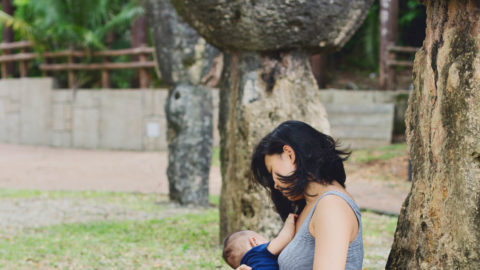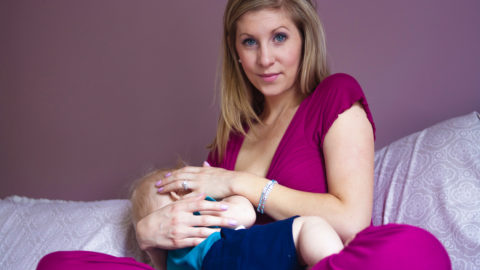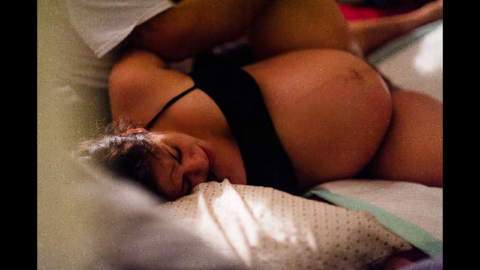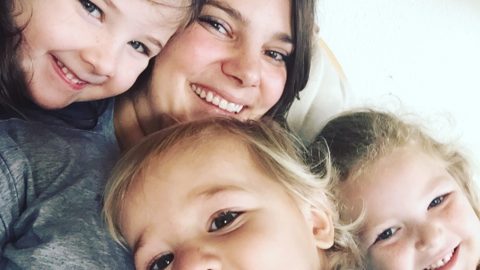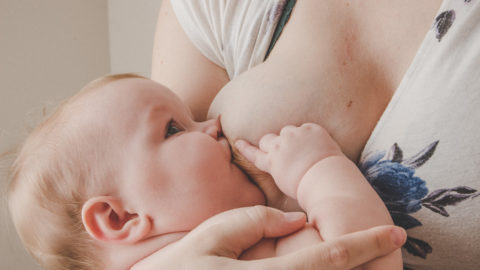
Lil Miss and I in our Tula Imagine Midday woven wrap.
I will admit, when I was a young child I thought babywearing was for hippies, and I certainly was not, nor was I ever going to be, a hippie. Based off cultural stereotyping and clichés I saw in movies, I thought hippies were naked, drug-loving, natural-smelling, responsibility-free, “tree-huggers.” I was completely unaware of what being a “hippie” really meant and how amazing it can be to follow “hippie ways,” two of which being babywearing and breastfeeding!
Although all the signs were there from the beginning, my family and I should have known I would grow up to have my life revolve around my babies and family, and practice attachment parenting. I fell in love with babywearing when I was able to carry my youngest brother. Born two weeks before my eighteenth birthday, I ended up being my two baby brothers’ nanny for the summer before going off to college. I had no idea that babywearing could be so convenient and great for bonding until then.

My husband and I carrying our babies.
When I became pregnant with my son, I knew I would babywear him and I was so excited about starting this journey with him. Little did I know I had a lot to learn with babywearing, including being able to breastfeed while wearing him. When I made my registry I only knew of one brand of babycarriers out there, and although it is a well-know name, I did not know of many other brands or ways to babywear. What I knew culturally in the U.S. about this brand of carrier was that most parents seemed to only babywear some of the time, while still mostly using infant carseats and strollers for the main way to multitask with babies. I assumed this was the case because babywearing was still new in a sense, and that it was only comfortable to wear your baby for short periods of time. Besides seeing a picture of Sacagawea in history class babywearing her baby on her back, I had no idea babywearing went so far back in history, in every culture around the world.

Wearing my son in our Smitten Tala Estella woven wrap.
Babywearing through history
When strollers became massed produced in the 1950s, babywearing or carrying was stereotyped as being poor and strollers were the best option to carry your baby so that you could do other chores and things faster and better. Just like midwifery, breastfeeding and almost all natural and best ways to parent and nurture our babies, babywearing was something to be ashamed of because it was for “less fortunate” parents. According to Gentleparenting.co.uk, “in Wales the Welsh blanket was used by both men and women regularly to carry babies until the 1950s,” when strollers became more popular. However, babywearing was a normal parenting art practiced for hundreds of years before.
In history and still today, many cultures all around the world used/use many different slings, wraps and carriers depending on the type of work the mother did/does and what the climate is like. In Mexico and Guatemala, they use the well-known Rebozo, which is a woven cloth square-shaped and tied over the shoulder usually with baby on the back. Peruvians use a Manta, which goes over both shoulders and baby is high on the back. In Europe, pouches, wraps and short cloth carriers are mostly used. Alaskans and Canadians use the Amauti, which is a large and thick jacket that contains a “baby pocket” in the back with an oversized hood to fit both mother and baby. In Papua New Guinea mothers use a Bilum, which is a bag made out of net supported from the mother’s forehead while the baby hangs on the back; talk about strong necks and mamas! In Asia there are a variety of carriers used, one such as the very popular Mei-tai. And African mothers use a Khanga, a short piece of fabric tied around the torso with baby low on mother’s back (Slingbabies.co.nz).

Babywearing my 3-year-old in our LilleBaby Toddler CarryOn during our visit to Seattle.
In 1972, the first German woven wrap company, Didymos, was established after its founder was inspired by a Mexican rebozo. In the early 1980s, a Hawaiian man invented the ring sling for his wife. Dr William Sears bought the idea and invented the term ‘attachment parenting’ and his wife, Mary invented the term ‘baby wearing’.

Wearing my baby in my own DIY, silk ring sling.
When it comes to breastfeeding and babywearing in history, it varies with climate. Babies need to breastfeed more frequently in hotter climates and “carriers that keep the baby close to mother tend to be more practical as they allow the baby to have very frequent, short feeds, avoiding dehydration,” stated by Gentleparenting.co.uk. Babies in colder climates tend to breastfeed less in the day, so they can be left for longer periods in carriers on the back or ones that can be put down while the mothers tends to her work.

Babywearing and breastfeeding my lil miss while we were visiting the Oregon Zoo. I’m wearing an Onya SSC.
Babywearing declined in western countries when the introduction of “baby trainers” insisted on restraining from spoiling our babies with too much love and attention. “It only took the first half of the 1900’s to undo centuries of mothering knowledge and support, and it has taken another 30 years to even begin healing this rift. Later research has quashed the ‘spoilt baby’ theory and we know now that lack of love and touch actually severely delays babies’ development. They need and indeed crave bodily contact and movement in order to thrive,” stated by Slingbabies.
So go babywear (and breastfeed) and #EmbraceYourWorld!
Happy International Babywearing Week 2015!
Be sure to join us in our social media accounts to be up to date with the progress of our project!
And… Don’t forget to share your brelfies using our HT #BreastfeedingWorld
–
I am a 27-year-old WAHM to two intelligent and amazing toddlers (3 and 1.5 years), and two stepdaughters (12.5 and 8.5 years). I am a very active and passionate birth advocate working to change regulations, laws and cultural norms in the U.S. to provide parents to be educated and empowered to know all birth rights and options. I am a proud emergency, unplanned c-section, turned all natural, non-medicated VBAC experienced mama! I am a modern-hippie mama practicing attachment parenting, who loves babywearing and toddlerwearing, and of course breastfeeding! I love to laugh with my amazing husband/best friend and to travel to new places with our beautiful family.
For more of my lifestyle and mommy blogging updates, check out my Instagram page @PRbabywearingMama.






